SYNOPSIS
!
SPOILER ALERT !
Victor Von
Doom is once again in search of the rare
and powerful metal ore Vibranium, and
because this precious metal can only be
found in Wakanda, Dr Doom once again
focuses on this hidden African kingdom
(just as he had done so previously in Astonishing Tales
#6).
But unlike that 1971 invasion of Wakanda,
Doom applies a far more subtle approach
this time around by essentially
masterminding a political coup which
overthrows the royal family of Wakanda
and enables him to take control of the
kingdom.
In Doomwar
#2, the second of a total of six issues,
the X-Men have arrived to help T'Challa
and the Black Panther (at this point in
time T'Challa's sister Shuri is the
Panther) regain a foothold in what is now
a Wakanda conquered and controlled by Dr.
Doom with the aid of local rebels. It is,
however, precisely the savageness with
which Shuri acts towards these groups of
her own people which starts to make the
X-Men feel more than just uneasy.
When
T'Challa makes it to the vibranium vault
he finds Dr. Doom at an impasse, as even
Storm (T'Challa's wife) cannot open the
final lock. Seizing the opportunity now
arisen, Doom leaves T'Challa with a
choice which is both simple and sinister:
either T'Challa's wife dies or he gives
up the secret of the vault.
Not
surprisingly, T'Challa chooses the latter
option... (to be continued)
|
|
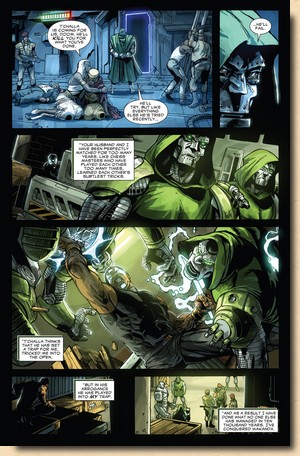
Doomwar #2
(May 2010)
|
|
|
| |
| |
REVIEW & ANALYSIS
2010 was a year
which saw Marvel throw an extraordinary number of cross-overs
at readers. The main focus and publicity output was on
"Siege" (which
saw Norman Osborn invade Asgard in the aftermath of yet
another crossover, "Dark Reign"), which then led into
"Heroic Age" (which saw Norman Osborn
defeated). Other cross-overs which were milked almost to
the breaking point with special and single issues in 2010
were "Shadowland" and "Chaos War".
But that was by no
means all. Minor" crossovers and "event
storylines" were "Realm of Kings",
"World War Hulks", "Second Coming",
"Thanos Imperative", "Curse of the
Mutants" - and "Doomwar". Given that none
of the big names of the time worked on Doomwar
it is hardly surprising that the six issues somewhat flew
underneath the radar amongst all the publicity clatter
put out by the House of Ideas to promote (some would say
hype) their "big names and big themes"
crossovers and limited series.
|
| |
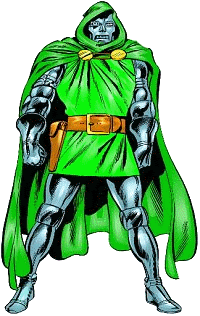 |
|
Which
is a shame. Even though Doomwar
received some very unfavourable comments
at the time, there were also those who
saw the strong points. Possibly the main
weakness was an overdose of super heroes
involved in the story, the combined
actions of which were at times somewhat
all over the place - in order to help
T'Challa and the Black Panther regain
control of Wakanda, no less than the
X-Men plus the Fantastic Four plus War
Machine plus Deadpool descended on the
African kingdom. Maybe it was the sales
desk's idea, hoping to attract attention
through this "more bang for your
bucks" formula, or maybe it was
writer Jonathan Maberry's bona fide idea
that it would energize the story.
Whichever it was, it didn't work.
What Maberry
got spot on, however, was the portrayal
of Dr Doom. The character has come a long
way since his debut in Fantastic Four
#5 (July 1962) where he was in essence a
vagrant madman who seemingly built
castles and machines of destruction all
by himself.
Only given
an actual origin story in Fantastic
Four Annual #2 (September 1964) he
was quickly promoted to being the leader
of a fictional state (Latveria) situated
in the Carpathian Mountains of Eastern
Europe, making him much more than just a
villain - he now was a dictator, and it
literally put him on the map of the world
which ultimately he sought to conquer and
rule.
|
|
|
| |
However, it also makes the
character a lot more ambivalent than any regular villain,
as Stan Lee himself pointed out many times:
"Everybody has
Doctor Doom misunderstood. Everybody thinks he's a
criminal, but all he wants is to rule the world. Now,
if you really think about it objectively, you could
walk up to a policeman, and you could say, 'Excuse
me, officer, I want to tell you something: I want to
rule the world.' He can't arrest you; it's not a
crime to want to rule the world." (Stan Lee
in Ricci, 2016)
|
| |
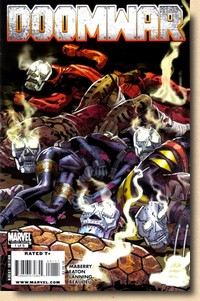
Doomwar #1 (of 6)
(April 2010)
|
|
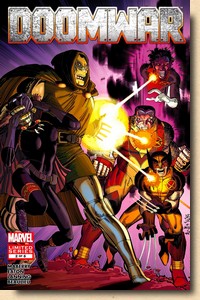
Doomwar #2
(May 2010)
|
|
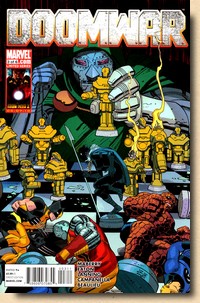
Doomwar #3
(June 2010)
|
|
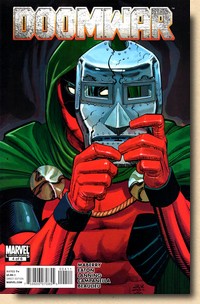
Doomwar #4
(July 2010)
|
|
|
|
| |
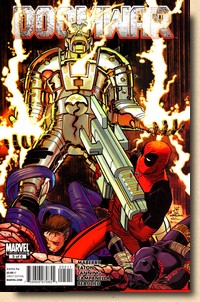
Doomwar #5
(August 2010)
|
|
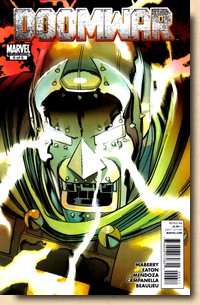
Doomwar #6
(September 2010)
|
|
"So
[...] it's unfair that he's
considered a villain, because
he just wants to rule the
world. Then maybe he could do
a better job of it. So I'm
very interested in Doctor
Doom, and I'd like to clear
his name." (Stan
Lee in Ricci, 2016)
Originally
written by Stan Lee as an
extremely arrogant person in the
1960s and early 1970s (which
ultimately would always lead to
the downfall of his schemes), he
became a more complex character
as of the late 1970s, with a
complicated background which
included a harsh upbringing and
the trauma of facial
disfiguration.
Maberry
latched on to this very well,
exploring the mental (im)balance
of a Dr Doom who - not unlike the
classic Dr Jekyll and Mr Hyde
juxtaposition - is constantly
slipping away just when you
thought you could put a label on
him.
|
|
|
|
| |
| Although always a matter of
taste, the artwork of Doomsday came across very
strong too, courtesy of penciller Scot Eaton and inkers Andy Lanning and
Robert Campanella. Eaton started working as a freelance artist
in the 1990s and has since worked for all of the major US
publishers. He drew well-known Marvel characters under
contract between 2005 and 2013 such as Captain America,
Thor, Spider-Man and the X-Men, and also put in a
significant amount of freelance work for DC, including
fan favourites such as the Batman, Swamp Thing and Green
Lantern. Eaton also worked on Crossgen's Sigil. His
powerful style which comes across the pages as being very
atmospheric and cinematographic in its rendition and
composition really gave Doom (and all the other
characters) the weight and presence needed.
|
| |
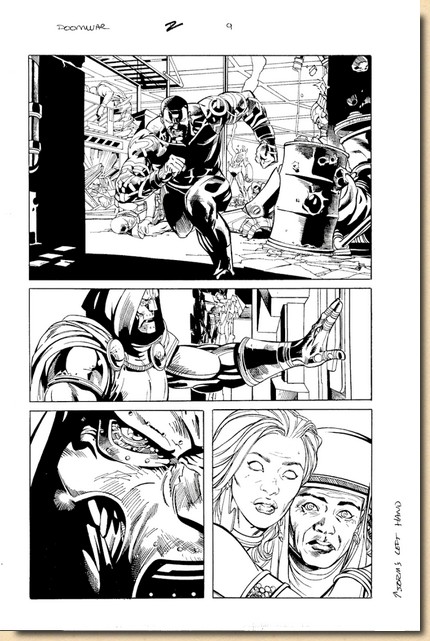 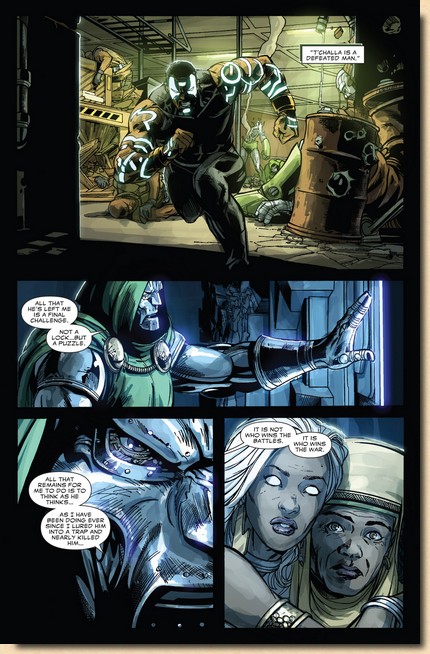
Original
artwork by Scot Eaton (pencils) and Andy Lanning &
Robert Campanella (inks)
for page 9 of Doomwar #2 (scanned from the original) -
and the same page as it appeared in print
|
| |
FACTS & NUMBERS
|
| |
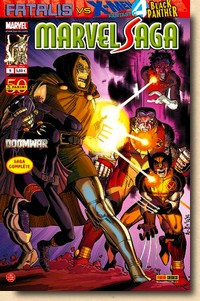 |
|
Given
the already mentioned somewhat reduced
publicity presence, the sales figures to
comic book stores for Doomwar #1
weren't too bad at just over 43,000
copies, making it the 33rd best selling
comic book of February 2010 - the
bestselling book being DC's Blackest
Night #7 with 130,000 copies
followed by Marvel's Siege #2 in
second place with 108,500 copies. Two variant covers
certainly pushed the sales a bit, but as
of Doomwar #2 the numbers were
going down, as is so often the case with
limited series.
While the
second issue still sold 30,500 copies,
this decreased slightly to roughly 28,000
each for issues 3 and 4. The two final
issues sold 26,000 (Doomwar #5)
and 25,000 (Doomwar #6) copies.
Overall these numbers didn't look too
bad, given that the length of the
mini-series (six issues) clearly pointed
to a collected edition - which in 2010
had become the central publishing concept
anyway. Published in October 2010, this
turned out to be a 144 page count
hardcover (Doomwar, ISBN
978-0-7851-4714-5) rather than just
another "trade paperback".
The entire
six issues of Doomwar were also
reprinted by Panini for the French market
in February 2011 in Marvel Saga
#9.
|
|
|
| |
|
| |
| BIBLIOGRAPHY RICCI K.J. (2016)
"Stan Lee Interview", Cat Country Youtube
Channel, 12 November 2016
|
| |
| |
The illustrations
presented here are copyright material.
Their reproduction for the review and
research purposes of this website is
considered fair use
as set out by the Copyright Act of 1976,
17 U.S.C. par. 107.

(c) 2019
|
|
|
|